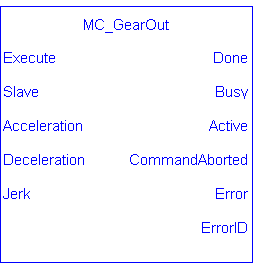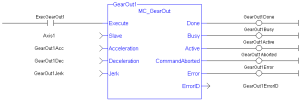![]()
 Function Block
Function Block![]() A function block groups an algorithm and a set of private data.
It has inputs and outputs. - Disengages the slave axis from a MC_GearIn or MC_GearInPos move or the master axis.
A function block groups an algorithm and a set of private data.
It has inputs and outputs. - Disengages the slave axis from a MC_GearIn or MC_GearInPos move or the master axis.
Inputs
|
Input |
Data Type |
Range |
Unit |
Default |
Description |
|---|---|---|---|---|---|
|
Execute |
BOOL |
0, 1 |
N/A |
No default |
On the rising edge |
|
Slave |
AXIS_REF |
1, 256 |
N/A |
No default |
Name of a declared instance of the AXIS_REF library function
|
|
LREAL |
No range |
User unit/sec2 |
No default |
Trapezoidal: Acceleration rate. S-curve: Maximum acceleration. |
|
|
Deceleration |
LREAL |
No range |
User unit/sec2 |
No default |
Trapezoidal: Deceleration rate. S-curve: Unused. |
|
LREAL |
No range |
User unit/sec3 |
No default |
Trapezoidal: 0 (zero). S-curve: Constant jerk. |
Outputs
|
Output |
Data Type |
Range |
Unit |
Description |
|---|---|---|---|---|
|
Done |
BOOL |
No range |
N/A |
Indicates the axis is disengaged from its master. |
|
Busy |
BOOL |
No range |
N/A |
Indicates the function is executing. |
|
Active |
BOOL |
No range |
N/A |
Indicates this move is the Active move. |
|
CommandAborted |
BOOL |
No range |
N/A |
Indicates the move was aborted. |
|
Error |
BOOL |
No range |
N/A |
Indicates either:
|
|
ErrorID |
INT |
No range |
N/A |
Indicates the error if the Error output is set to TRUE. |
Remarks
-
- This function block starts a motion-related action and stores data for calculations and error checking.
See Call Function Blocks Multiple Times in the Same Cycle if using a dual-core controller.
This function block:
- Aborts the active MC_GearIn or MC_GearInPos move.
- Disengages the axis from its master.
- Commands the axis to continue at its current velocity
 For a group of axes this means: In ACS the velocities of the different axes. In MCS and PCS it provides the velocity of the TCP.
For a group of axes this means: In ACS the velocities of the different axes. In MCS and PCS it provides the velocity of the TCP. - See Function Blocks - General Rules about how inputs and outputs work.
-
-
The current velocity is calculated by taking the average of the actual velocity during the previous 16 cycles.
- The control continues to command the axis to move at this velocity until this MC_GearOut move is aborted.
- The Acceleration, Deceleration, and Jerk input parameters are applied if this command velocity is modified by the MC_SetOverride function block.
- If this function block is called, and the active move is not a MC_GearIn or MC_GearInPos move, this function block returns an error and the active move is not aborted.
-
-
The MC_GearOut is done when the slave axis is disengaged from the master axis.
Once done, the MC_GearOut remains busy and active until it is aborted by a different motion function block.
This is different behavior than most other motion function blocks.
The MC_GearOut function block represents an exception to the exclusivity rule as the Done and Active outputs may be true at the same time.

Figure 1: MC_GearOut
FBD Language Example
Not available.
FFLD Language Example
IL Language Example
Not available.
ST Language Example
(* MC_GearOut ST example *)
Inst_MC_GearOut(ExecGearOut1,Axis1,GearOut1Acc,GearOut1Dec,GearOut1Jerk);
//Inst_MC_GearOut is instance of MC_GearOut
See Also







